Hosted Space Payloads Almost Ready For Liftoff; Harris, Iridium Pair On Aireon
Posted on

UPDATED: Air Force General Praises CHIRP, Hosted Payloads
COLORADO SPRINGS, NATIONAL SPACE SYMPOSIUM: After almost a decade of discussion, hope and frustration, the time appears to finally be ripe for what the space industry calls hosted payloads, the Remora fish of satellites.
The Air Force’s Space and Missile Systems Center, which has long been wary but intrigued by them, has drafted an indefinite delivery/indefinite quantity (IDIQ) contract for hosted payloads, Maj. Gen. Martin Whelan, director of requirements at Air Force Space Command said last night. The command also recently created a Hosted Payload Office.
On the industry side, Harris Corp. is building what appears to be a commercially viable hosted payload system to improve global air traffic control and thus save fuel for airlines. The system, called Aireon, will be hosted on the next generation of 66 Iridium satellites. (If you look at the artist’s rendering of the Iridium satellite above, the Aireon payload is the white and gold box on the front bottom of the bird.) Iridium and NAV CANADA, the private Canadian air navigation service, have formed a joint venture, Aireon LLC, to provide the space-based GPS system to airlines. That company contracted with Harris to provide the technology and the hosted payload, based on Harris’ decades providing highly classified SIGINT and other sensors that operate in low earth orbit.
In an Russian-nesting-doll wrinkle to the hosted payload saga, SMC is likely to put a radiation dosimeter on the Aireon payload — a hosted payload payload. The dosimeter would measure Low Earth Orbit space radiation to let Space Command better judge whether its satellites are being jammed or are being hit by radiation from a solar flare or other natural source, Bill Gattle, vice president for aerospace at Harris, told reporters. Although the Aireon payload boasts three additional slots so it could carry more payloads, the dosimeter would attach to the satellite with its own cable and live in a box attached to Aireon.
The fact that no one has yet come forward to place more payloads on Aireon, as Harris and Irdium both clearly hope will happen, is indicative of the caution with which both industry and the military continue to approach hosted payloads. Interested parties still have time to propose payloads to the companies,
The first military hosted payload, the Commercially Hosted Infrared Payload (CHIRP), lifted off on the SES-2 satellite in 2011 and is functioning. UPDATED 1:22PM During the “acquisition lunch” at NSS today, Brig. Gen. Roger Teague, the director of strategic plans, programs and analyses at Air Force Space Command, called CHIRP a “tremendous success,” noting it had gone contract to orbit within 35 months and had “met all its mission requirements.”
Northrop Grumman delivered in late February the first of two of the Air Force’s Enhanced Polar System (EPS). It’s a highly capable communications payload that will be hosted on other, unidentified (NRO?) satellites, to provide polar coverage for secure, jam-resistant, strategic and tactical military communications.
The reasons for the growing military commitment to hosted payloads? Tight budgets and the disastrous record of space acquisition from the Clinton through the Bush administrations. If you want to see Air Force, Intelligence Community and industry experts cringe, just say NPOESS or FIA. SBIRS may get a grimace, but it’s performing so well that everyone has largely forgiven its enormous cost and schedule overrruns. And there was US 193, famously shot down when it failed soon after launch.
A major factor in the failures or cost and schedule overruns for the above programs was the approach of the Clinton administration, which insisted on sticking every possible sensor on a very small number highly capable satellites. That approach strained the technical capabilities of both the government and industry and has led, in part, to what Gen. William Shelton, head of Air Force Space Command, calls “disaggregation,” which roughly translates as putting fewer sensors on single satellites, placing hosted payloads on both military and commercial satellites and buying services from industry and other countries.
While she may not cite the above reasons for the increased military commitment to hosted payloads, Harris’ Janet Nickloy said yesterday that SMC knows “they need to look at the world differently.” By the way, Nickloy is chair of the Hosted Payload Alliance.
Subscribe to our newsletter
Promotions, new products and sales. Directly to your inbox.
